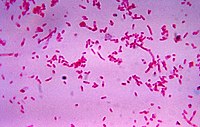
Photo from wikipedia
Abstract Large volumes of rumen fluid are continuously discharged from slaughterhouses, which are typically transported to facilities for treatments of lignocellulosic biomass. Recovery of fibrolytic microorganisms from the rumen fluid… Click to show full abstract
Abstract Large volumes of rumen fluid are continuously discharged from slaughterhouses, which are typically transported to facilities for treatments of lignocellulosic biomass. Recovery of fibrolytic microorganisms from the rumen fluid enables to reduce the load for wastewater treatment and transportation of rumen fluid. However, there is no standardized method for recovering ruminal microorganisms. Here, we established a flocculation-based method with an optimized flocculant concentration required to recover ruminal microorganisms with fibrolytic activity. Rumen fluid was flocculated with poly-ferric sulfate at 0.4%, 0.7%, 1.0%, and 2.0% and with an inorganic neutral flocculant at 13.0%. Poly-ferric sulfate at 0.4%, 0.7%, and 1.0% effectively recovered ruminal microorganisms, which resulted in an 85.6%, 77.3%, and 75.6% reduction in rumen fluid volume, respectively. These recovered microorganisms retained the endoglucanase activity at 52 kDa and 53 kDa in size. In addition, recovery of ruminal microorganisms allowed for substantial reductions in the solids and organic compound concentrations of the filtrates after the flocculation. As a practical demonstration of this method, tomato leaves were treated with the flocculated rumen fluid at 37 °C for 48 h. Hydrolysis of the tomato leaves using the rumen fluid flocculated with 0.7% poly-ferric sulfate demonstrated elevated endoglucanase activity at 37 kDa, 46 kDa, 57 kDa, 61 kDa, and 66 kDa in size during treatment. Therefore, 0.7% poly-ferric sulfate is the optimal concentration for recovering ruminal microorganisms while maintaining their fibrolytic activity. This is the first study which suggest a novel method to efficiently recover ruminal microorganisms from huge amounts of rumen fluid offers a practical and sustainable solution to reduce the load for wastewater treatment at slaughterhouses and in the transportation of rumen fluid.
Journal Title: Journal of Cleaner Production
Year Published: 2020
Link to full text (if available)
Share on Social Media: Sign Up to like & get
recommendations!